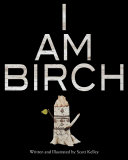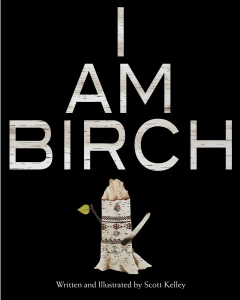Reviewed by Debbie Reese
Review Source: American Indians in Children’s Literature
Book Author: Scott Kelley
A colleague wrote to ask me about Scott Kelley’s I Am Birch. Published in 2018 by Islandport Press, it is getting a ‘not recommended’ from me.
In the back of I Am Birch is an “About the Book” page that tells readers that: The legends of Gluskap were part of artist Scott Kelley’s childhood. One in particular, “How Rabbit Got Long Ears,” was a favorite. In it, Rabbit tells the other animals that the sun is not going to rise again, and Gluskap must set the record straight.
Kelley had been working on a series of paintings of Wabanaki tribal elders, and another series of animals from the Maine woods. The story of Rabbit had been playing in his head for months, until he remembered a little drawing of a birch tree he had made, and at last, I Am Birch came to life: chaos and fear as seen by a birch stump, who, against all expectations, manages to put those fears to rest.
I am a former schoolteacher. Some people think books are just meant to entertain — but they definitely educate, too. What do students learn by reading I Am Birch?
Given the illustrations (I’ve included several, below) and the information in the “About the Book” page, I Am Birch looks like it is a Native story. So, I would try to figure out a few things.
First: Is the author Native?
The answer? No. Kelley isn’t Native. Course, that doesn’t mean he can’t tell create words or illustrations that look like they’re meant to be be Native, but when someone chooses to create content that they’re putting forth as Native, they must do a lot of research, first.
So, that’s the second question. Does the author provide us with information about his research? Or, his resources? One of the touchstone articles about sources for is Betsy Hearne’s Cite the Source.
The answer? No. Nothing of that sort is listed in the book. I have no doubt that Scott Kelley meant well. But the images of Indigenous people that most Americans carry around are deeply flawed. Knowing they’re flawed is the first step. Becoming aware of the big and small ways they’re flawed starts by doing research — not of standard sources — but of books written by the people they are writing about. Because Kelley’s book is about the Wabanaki peoples, he could start by reading nonfiction by Lisa Brooks. She is Abenaki. Zooming out a bit, he could also read a book by an Indigenous scholar like Daniel Heath Justice. His Why Indigenous Literatures Matter is new and an outstanding resource about our literatures. Continue reading.


I Am Birch by Scott Kelley
Published by Islandport Press on April 24, 2018
Genres: American Indians First Nations Metis Inuit
Pages: 32
Reading Level: Grades 1-2
ISBN: 9781944762391
Review Source: American Indians in Children's Literature
Publisher's Synopsis: A birch tree is an unlikely champion and protector of the forest in this story inspired by Gluskap, the heroic and kind-hearted figure of Wabanaki legends. As rumors of coming cold and darkness spread through the woods, chaos and fear grow. In a panic to collect and store food, the animals do damage to their very homes. The birch, now only a stump, remains firmly rooted and, with the wisdom and dry humor that only a stump can possess, helps the animals put their fears to rest.
Acclaimed fine art painter Scott Kelley used his portraits of Wabanaki tribal elders as a springboard for the extraordinary paintings that make this a children's book like no other.

Leave a Reply